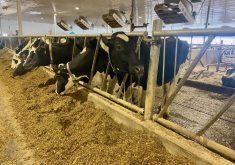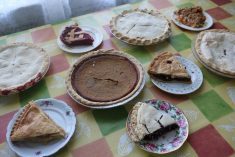MARTENSVILLE, Sask. – Tony Boldt comes by his interest in livestock genetics honestly.
Boldt’s dad was a well-known breeder of purebred polled Herefords at his farm in central Saskatchewan. He left the business about 30 years ago, selling the entire herd to hockey legend Bobby Hull.
Today, Tony resides on the same farm, along with his wife, Sheri, and their eight-month-old son, Zach.
In 2001, he restocked the farm’s pastures with livestock but unlike his dad, he chose bison.
Read Also

Farmland ownership fires up Saskatchewan politicians
Saskatchewan politicians debate the enforcement of farmland ownership laws in the province.
Boldt, who graduated from the University of Saskatchewan with a diploma in agriculture, visited a bison farm near St. Louis, Sask., while a student. At the time, he had no experience with bison and knew little about them but saw them as the best opportunity.
Boldt, who built special fences and a new corral, said bison are hardy animals that require relatively little care. This was an important consideration because Boldt also works at the former Can-Oat milling plant, now owned by Viterra.
Boldt did not want livestock that would require constant attention, particularly during calving season in March and April.
He said bison are good calvers and the newborns require little if any doctoring.
Boldt feeds the animals alfalfa or alfalfa and grass, depending on what is available locally. Good quality hay usually commands a premium price in the Martensville area, partly because there are a lot of horse owners requiring feed.
“I try to feed them the best stuff I can get,” said Boldt.
He got into the bison business to sell top quality breeding animals but he has sold animals into the meat market and slaughters a few for his own use.
“Pretty much everything I sell now is for breeding,” said Boldt, who keeps about 40 animals on two quarter sections of farmland.
“I don’t have enough land to keep a bunch of mediocre animals that you really can’t command your own price for.”
In building the herd, Boldt searched for animals that offered good genetics and a heavier, meatier carcass.
He travelled across the Prairies and sought advice from bison producers. Eventually, Boldt landed a deal with a retiring bison producer from Medicine Hat, Alta. Southern Alberta was in the middle of a drought and feed was scarce.
Boldt hand picked 20 bison and shipped them to his farm. His bison are M-Line animals, descended from a herd that was bred by North Dakota bison producer Ken Throlson.
According to Boldt, M Line animals are slightly heavier than most Plains bison. He also has a bull whose lineage is connected to a wild herd that resided in the Theodore Roosevelt National Park in North Dakota.
Roosevelt bison are also known for their meaty carcass and heavy conformation relative to other lines of Plains bison.
After BSE brought the bison industry to its knees, many producers liquidated their herds and sold their animals into meat markets.
Some producers stopped maintaining records because documenting an animals’ pedigree was a low priority.
As a result, many of the bulls available today have an unknown or undocumented pedigree.
When Boldt entered the business about nine years ago, prices for bison meat were down and producers were reluctant to spend top dollars on breeding stock.
“The first couple of years were a disaster,” said Boldt.
“Just after I bought my animals, the drought came and feed prices went through the roof, like $120 or $130 for a bale. Then BSE came, and markets stayed down even longer.
“For the past few years though, prices have been coming up and right now it’s really good.”
When markets were poor, Boldt sold top-quality breeding animals for around 85 cents per pound liveweight, hardly enough to cover the costs of feeding.
This year, he is selling breeding animals for $1.50 a pound out of the yard.
He said the same animals could fetch as much as $1.70 at show sales. By selling from the yard, he saves the costs of transportation and commission.
Boldt would like to maintain his herd at about 25 breeding animals.
“I never sell my best animals. I like to keep my best at home,” he said.
Boldt’s animals are also starting to gain a reputation among commercial bison producers.
Recently, he had his entire herd registered as Pure Plains breeding stock. And last year, a 2008 bull calf from his farm took second place in the breeding category at the Saskatchewan Bison Association’s Premium Stock Show and Sale.
That has opened the door to new sales and inquiries from potential customers.
“I like to go to the shows and compare myself to some of the top guys,” said Boldt.
“I was lucky I spent as much time looking into genetics as I did because now, guys are starting to come to me.”















